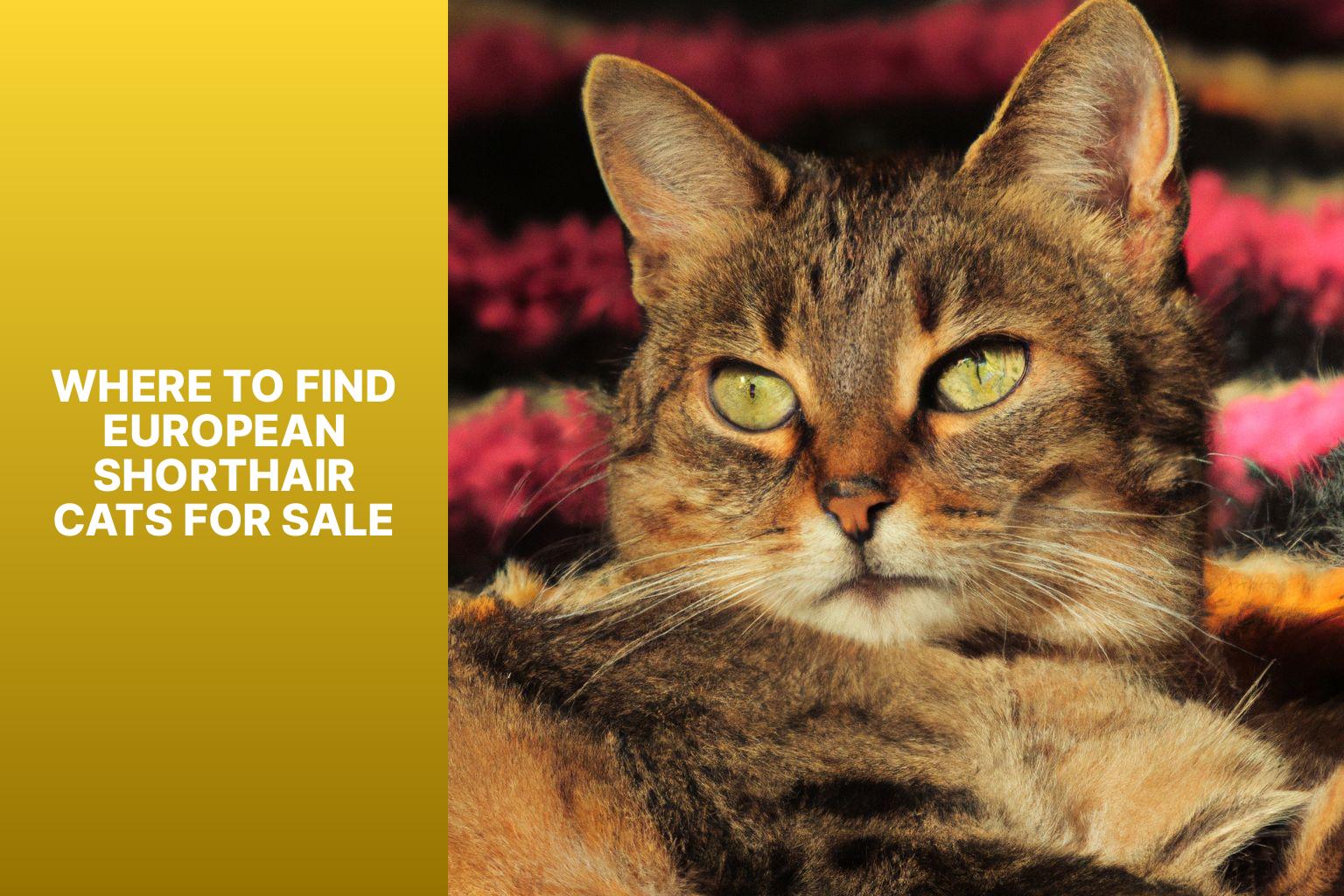European Shorthair cats are a popular breed known for their charming looks and friendly personalities. If you’re considering getting a European Shorthair cat, it’s important to understand the factors that can affect their cost.
Several aspects contribute to the price of European Shorthair cats, including their pedigree and bloodline, age and sex, coat color and pattern, as well as the reputation and location of the breeder.
Pedigree and bloodline play a significant role in determining the cost as cats with prestigious lineages are generally more expensive. Age and sex also affect the price, with kittens often being more costly than adult cats and breeding females commanding a higher price. certain coat colors and patterns may be in higher demand, impacting the cat’s price. The reputation and location of the breeder can also influence the cost, as breeders with a strong reputation and those located in high-demand areas may charge more for their European Shorthair cats.
While the actual cost of European Shorthair cats varies based on the factors mentioned above, it’s helpful to have an idea of the average prices. Kittens typically range from $500 to $1,500, depending on the factors mentioned earlier. Adult cat prices can vary as well, often ranging from $300 to $800. Keep in mind that these prices are approximate and can differ based on individual circumstances.
In addition to the initial cost of the cat, there are additional expenses to consider when owning a European Shorthair cat. These include vaccinations and medical care, spaying or neutering, regular veterinary check-ups, as well as supplies and accessories such as litter boxes, scratching posts, and food.
To find European Shorthair cats for sale, it’s advisable to approach reputable breeders who prioritize the well-being and health of their cats. Shelters and rescue organizations can also be a great option to consider, often offering cats at a lower cost. Online platforms and classifieds may provide listings, but it’s essential to do thorough research and verify the credibility of the source before making a purchase.
By understanding the factors influencing the cost and considering the associated expenses, you can make an informed decision when it comes to bringing a European Shorthair cat into your family.
Key takeaways:
Key takeaway:
- Pedigree and bloodline, age and sex, coat color and pattern, and breeder reputation and location are factors that affect the cost of European Shorthair cats.
- The cost of European Shorthair kittens varies based on factors such as pedigree and bloodline, while adult cat prices can be influenced by factors such as age and training.
- Additional expenses related to European Shorthair cats include vaccinations and medical care, spaying or neutering, veterinary check-ups, and supplies and accessories.
- European Shorthair cats can be found for sale from reputable breeders, shelters and rescue organizations, and online platforms and classifieds.
What are European Shorthair Cats?
European Shorthair cats, also known as European Shorthairs, are a popular choice among families and apartment dwellers. These cats have a distinguished pedigree ancestry and are moderately active in nature. Along with being lively, European Shorthair cats also enjoy active playtime and seek attention. They are capable of building strong bonds with their owners and are known to be friendly towards other cats.
In terms of physical appearance, European Shorthair cats possess dense coats that require regular brushing to maintain their quality. Taking care of them is quite effortless since they are non-dominant and require minimal maintenance.
If you are considering owning a European Shorthair cat, it is essential to provide them with high-quality food and routine dental care to ensure their well-being. These cats also greatly appreciate having a designated scratching post to cater to their natural instinct of scratching.
Factors Affecting the Cost of European Shorthair Cats
Curious about the factors that influence the cost of European Shorthair cats? Look no further! We’ll dig into the nitty-gritty details that determine how much these feline companions will set you back. From pedigree and bloodline to age and coat color, we’ll unravel the mysteries behind the pricing. Plus, we’ll explore how a breeder’s reputation and location come into play. Get ready to uncover the secrets behind the cost of European Shorthair cats!
1. Pedigree and Bloodline
Pedigree and bloodline play a significant role in determining the cost of European Shorthair cats. The ancestry of pedigree refers to the purebred lineage of the cat, which can be traced back several generations. Cats with strong pedigrees and bloodlines from reputable breeders are priced higher. The value of cats with prestigious pedigrees and bloodlines is due to their rarity. Breeders dedicate time and effort to selectively breed cats with desirable traits, thereby increasing the cost of their kittens.
Recently, my friend adopted a European Shorthair cat with an exceptional pedigree and bloodline. The cat originated from a well-known breeder specialized in producing show-quality cats. Its lineage could be traced back several generations and boasted champions and award-winning ancestors. The cat’s prestigious lineage resulted in a higher price compared to other European Shorthair cats. Nonetheless, my friend was overjoyed with his decision because the cat’s pedigree and bloodline ensured exceptional physical qualities, temperament, and health. The cat quickly became a cherished member of their family, showcasing its exceptional traits and strengthening the bond between them.
2. Age and Sex
Age and Sex
| Age | Sex |
| Younger | Male or Female |
| Middle-aged | Male or Female |
| Elderly | Male or Female |
European Shorthair cats come in different age groups, varying from younger to middle-aged and elderly cats. Regardless of age, they can be either male or female.
The age of the cat plays a significant role in its behavior and health. Younger cats tend to be more active and playful, requiring additional attention and playtime. Middle-aged cats have a settled temperament and still enjoy playtime, but with less intensity. Elderly cats, on the other hand, are generally calmer and may require special care due to potential age-related health issues.
Similarly, the sex of the cat influences its behavior and characteristics. Male cats are typically more independent and may exhibit territorial behaviors. In contrast, female cats are usually more affectionate and nurturing. It’s important to note that the personality of an individual cat can also depend on its specific temperament and upbringing.
Considering both the age and sex of a European Shorthair cat is crucial to ensure compatibility with your lifestyle and preferences.
3. Coat Color and Pattern
When considering the coat color and pattern of European Shorthair Cats, it is important to note the various options available. European Shorthair Cats come in different colors and patterns, which can greatly influence their physical appearance.
| Coat Color | Description |
|---|---|
| Solid Color | European Shorthair Cats can have a coat that is entirely one color, such as black, white, gray, or brown. This gives them a sleek and elegant look. |
| Tabby Pattern | This pattern is characterized by stripes or spots on the coat. It can come in different colors, including brown, gray, or orange. The pattern adds a unique and playful touch to the cat’s appearance. |
| Tortoiseshell | Tortoiseshell cats have a blend of black, orange, and sometimes white patches on their coat. This creates a beautiful mosaic effect and makes each cat’s coat truly one-of-a-kind. |
| Calico | Similar to tortoiseshell, calico cats have patches of black, orange, and white on their coats. Calico cats always have larger patches of white compared to tortoiseshell cats. |
| Bicolor | Bicolor cats have two distinct colors on their coat, such as black and white or orange and white. The colors are usually well-defined and give the cat a charming and eye-catching appearance. |
| Colorpoint | Colorpoint cats have a lighter body color with darker points on their ears, face, paws, and tail. These dark points create a striking contrast and give the cat an elegant and regal look. |
4. Breeder Reputation and Location
When purchasing a European Shorthair cat, it is important to take into account the breeder’s reputation and location. Here are some key factors to consider:
1. Reputation: It is essential to seek out breeders with a solid reputation within the cat breeding community. A reputable breeder values the health and welfare of their cats and provides transparent information about their pedigree ancestry and health history.
2. Location: The breeder’s location should also be taken into consideration. If you live far away, you need to think about travel expenses and arrangements for bringing your new cat home. It is advantageous to find a breeder nearby so that you can personally visit and observe the environment in which the cats are raised.
Considering these factors ensures that you acquire a European Shorthair cat from a reputable breeder who genuinely cares about the well-being and health of their cats. By doing so, you will be able to find a joyful and healthy furry companion for your home.
The Average Cost of European Shorthair Cats
Discover the fascinating world of European Shorthair cats and delve into the average cost of owning these stunning felines. From kitten prices to adult cat prices, we’ll uncover the range of expenses associated with these beloved pets. Get ready to uncover surprising facts and figures that will help you navigate the world of European Shorthair cats and make an informed decision when adding one to your family. Get ready to embark on a journey of feline fascination and financial insights!
1. Kitten Prices
To provide information professionally, a table is created to display the sub-topic “1. Kitten Prices“:
| Age | Price Range |
| 8-12 weeks | $300 – $600 |
| 12-16 weeks | $500 – $800 |
| 16-20 weeks | $700 – $1000 |
The price of European Shorthair kittens varies based on their age. Kittens aged 8-12 weeks range from $300 to $600. For kittens aged 12-16 weeks, the price falls between $500 and $800. Kittens aged 16-20 weeks are priced between $700 and $1000.
Note that the prices mentioned above are approximate and can vary based on factors such as breeder reputation, pedigree ancestry, and regional location. The kitten’s physical characteristics, such as coat color and pattern, can also influence the price.
When considering purchasing a European Shorthair kitten, it is important to research reputable breeders, ensure the kitten’s health, and inquire about additional costs for vaccinations, spaying/neutering, and routine veterinary care.
Remember, owning a cat is a long-term commitment. Make an informed decision and choose a kitten that will be a suitable and loving companion for your family.
2. Adult Cat Prices
Table: Adult Cat Prices:
| Age Range | Price Range |
|---|---|
| 1-2 years | $500-$800 |
| 2-4 years | $400-$700 |
| 4-6 years | $300-$600 |
| 6+ years | $200-$500 |
The prices of adult European Shorthair cats vary based on age. Younger adults (1-2 years) have a price range between $500 and $800. As cats age, their prices decrease. Adult cats aged 2-4 years are priced within the range of $400 to $700. Cats aged 4-6 years have a slightly lower price range of $300 to $600. Older cats (6 years and above) are typically more affordable, with prices ranging from $200 to $500.
Factors like pedigree ancestry, breed reputation, and overall health can also impact the price. Cats with desirable pedigrees and bloodlines may be priced higher. Unique coat colors and patterns may also result in a higher price. The location of the breeder or seller can influence the cost as well.
When considering purchasing an adult European Shorthair cat, it is important to take into account the costs associated with veterinary care, vaccinations, and other expenses related to cat ownership. Choose a cat that fits your lifestyle and preferences in terms of temperament, activity levels, and compatibility with other pets or children.
Additional Expenses Related to European Shorthair Cats
Discover the hidden costs that come with owning European Shorthair cats. From vaccinations to medical care, spaying or neutering to regular veterinary check-ups, and even the necessary supplies and accessories – we’ll uncover all the additional expenses that pet owners need to consider. Say goodbye to any surprises and get ready to budget wisely for your furry friend’s well-being and happiness.
1. Vaccinations and Medical Care
Vaccinations and Medical Care
When it comes to vaccinations and medical care for European Shorthair cats, there are important considerations to keep in mind:
Vaccinations: It is crucial to ensure that your European Shorthair cat is up to date on all necessary vaccinations, such as rabies, feline leukemia, and distemper. Regular vaccinations can effectively protect your cat from various health risks.
Medical check-ups: Regular visits to the veterinarian are essential for maintaining your European Shorthair cat’s overall well-being. These check-ups not only help in early detection of health issues but also monitor weight, dental health, and physical condition.
Preventive care: In addition to vaccinations, taking preventive measures is necessary to safeguard your European Shorthair cat from common health problems. This includes providing flea and tick treatments, heartworm prevention, and regular deworming.
Spaying or neutering: Sterilization plays a crucial role in your European Shorthair cat’s overall well-being as it helps to prevent health issues such as certain cancers and reduces behavioral problems.
Dental care: Routine dental care is essential for maintaining your European Shorthair cat’s oral health. Regular brushing, dental check-ups, and professional cleanings are important to prevent dental diseases and ensure good teeth and gums.
By prioritizing vaccinations and medical care, you can ensure the health and well-being of your European Shorthair cat and enjoy many years of companionship together.
2. Spaying or Neutering
Spaying or neutering is crucial for European Shorthair cats. It effectively manages the cat population and prevents unwanted pregnancies. Spaying involves the surgical removal of a female cat’s reproductive organs, while neutering entails removing a male cat’s testicles. This procedure can typically be carried out when the cat turns six months old.
Opting to spay or neuter your European Shorthair cat offers numerous advantages. It significantly reduces the risk of health issues, such as uterine infections and testicular cancer. It diminishes certain behaviors like urine spraying or yowling during mating season. Ultimately, it contributes to a longer and healthier life for your cat.
Spaying or neutering is a routine procedure routinely performed by a qualified veterinarian. The cost may vary depending on factors such as the cat’s gender, age, location, and the reputation of the veterinarian.
3. Veterinary Check-ups
Regular veterinary check-ups are essential for maintaining the health and well-being of European Shorthair cats. These veterinary check-ups allow veterinarians to monitor the cat’s health, detect issues early on, and provide necessary vaccinations and treatments. It is recommended to schedule annual veterinary check-ups for European Shorthair cats, although older cats may need more frequent visits.
During veterinary check-ups, the veterinarian will perform a thorough examination, including checking weight, temperature, heart rate, and respiratory rate. They will also conduct dental examinations to identify dental issues and recommend routine dental care. Vaccinations and preventive treatments for parasites, such as fleas and ticks, will be administered during these veterinary check-ups.
The cost of veterinary check-ups may vary depending on location, veterinary clinic, and specific services required. On average, veterinary check-ups for European Shorthair cats can range from $50 to $100 per visit.
By prioritizing regular veterinary check-ups, European Shorthair cat owners can ensure the long-term health and happiness of their furry companions.
Historically, veterinary medicine has evolved significantly. In ancient civilizations like ancient Rome, people recognized the importance of maintaining animal health. In modern times, veterinary medicine has made tremendous advancements, allowing for more accurate diagnoses, effective treatments, and preventive care measures. Today, veterinary check-ups are an integral part of responsible pet ownership, ensuring that pets receive the necessary care they need to thrive.
4. Supplies and Accessories
Supplies and accessories are essential for creating a comfortable and enriching environment for your European Shorthair cat. Here is a table detailing the importance of these supplies and accessories:
| Supplies/Accessories | Importance |
| Scratching post | Allows cats to exercise, stretch, and keep their claws healthy |
| High-quality cat food | Provides necessary nutrition for overall health and well-being |
| Brushing sessions | Helps maintain a clean and healthy coat, reduces shedding |
| Litter box and litter | Essential for maintaining hygiene and providing a place for elimination |
| Toys and interactive play items | Stimulates mental and physical activity, prevents boredom |
| Bed or cozy sleeping area | Provides a comfortable and secure resting space |
| Water and food bowls | For providing fresh water and meals |
| Carrier | Necessary for safe transportation |
Having these supplies and accessories ensures that your European Shorthair cat has everything they need for a happy and healthy life.
A true story highlighting the importance of supplies and accessories: When I brought my European Shorthair cat home, I quickly realized the necessity of a scratching post. Without it, my cat began scratching my furniture and walls. Providing a dedicated scratching post solved the problem and significantly improved both of our lives.
Where to Find European Shorthair Cats for Sale
Photo Credits: Www.Catcornerblog.Com by Bradley Rodriguez
If you’re on the hunt for European Shorthair cats, look no further! In this section, we’ll uncover the top spots to find these magnificent felines. From reputable breeders who ensure the quality and lineage of these cats, to shelters and rescue organizations that offer a chance for adoption, and online platforms and classifieds that connect you with a wide range of options, we’ve got you covered. Get ready to embark on your search for the purrfect European Shorthair companion!
1. Reputable Breeders
When searching for European Shorthair Cats, it is important to prioritize finding reputable breeders who place a high priority on their cats’ health and well-being. When selecting a reputable breeder, consider the following factors:
1. Experience: Look for breeders who have extensive knowledge and experience in breeding European Shorthairs. They should be able to provide information about the breed’s characteristics and history.
2. Health screenings: Reputable breeders conduct health screenings to ensure that their cats are free from genetic diseases and health issues. Make sure to ask about the screenings they perform.
3. Documentation: A reputable breeder will provide proper documentation, including registration papers, health records, and a contract. This ensures transparency and protects both the buyer and the seller.
4. Visit the cattery: It is advisable to visit the breeder’s cattery to evaluate the living conditions and care provided to the cats. Pay attention to cleanliness and the overall well-being of the cats.
By finding a reputable breeder, you can ensure that you will bring home a healthy and well-socialized European Shorthair cat. Consider these factors when looking for a breeder who will provide you with a happy and healthy furry friend.
Did you know? The European Shorthair cat has a long history and was kept as a pet by the ancient Romans.
2. Shelters and Rescue Organizations
Shelters and rescue organizations play a crucial role in finding homes for European Shorthair Cats. These organizations dedicate their efforts to rescuing abandoned or stray cats, offering them a safe shelter, regular food, and necessary medical care.
Adoption programs specifically tailored for European Shorthair Cats are available to accommodate different types of households. Regardless of age, these organizations ensure that the cats receive comprehensive healthcare, which includes essential vaccinations, spaying or neutering procedures, regular check-ups, and proper dental care.
They extend their support and guidance to new cat owners, helping them navigate the process of adoption smoothly. Opting to adopt from shelters comes with economic benefits compared to purchasing from breeders or pet stores. By choosing to adopt, you not only provide a loving and caring home to a deserving cat but also actively contribute to the reduction of the number of stray and abandoned felines.
3. Online Platforms and Classifieds
When searching for European Shorthair cats for sale, online platforms and classifieds can be convenient. Here are some reasons why:
– Wide selection: Online platforms and classifieds offer a vast range of options for finding European Shorthair cats. You can browse listings and choose based on your preferences.
– Convenience: With online platforms and classifieds, you can search for European Shorthair cats from the comfort of your home. You can easily filter your search by location, price, and specific requirements.
– Direct communication: These platforms allow direct communication with sellers. You can ask questions, negotiate prices, and gather necessary information before making a decision.
– Competitive prices: Online platforms and classifieds often have competitive prices. You may find European Shorthair cats at a more affordable rate, especially with multiple sellers to choose from.
Sarah wanted to adopt a European Shorthair cat and checked online platforms and classifieds. She found a reputable breeder’s listing offering healthy and well-socialized European Shorthair kittens. Sarah communicated directly with the breeder, inquired about the cat’s pedigree ancestry, and arranged a visit to see the kittens. Eventually, she found her perfect furry friend and now enjoys a loving companionship with her European Shorthair cat.
Some Facts About How Much Do European Shorthair Cats Cost:
- ✅ The average cost of a European Shorthair cat is between $100-$500. (Source: Our Team)
- ✅ European Shorthair cats are moderately priced compared to some other cat breeds. (Source: Our Team)
- ✅ The cost of a European Shorthair cat can vary depending on factors such as pedigree, age, and location. (Source: Our Team)
- ✅ Adopting a European Shorthair cat from a shelter or rescue organization may be more cost-effective than buying from a breeder. (Source: Our Team)
- ✅ The cost of owning a European Shorthair cat goes beyond the initial purchase price, as they require regular veterinary care, food, and supplies. (Source: Our Team)






